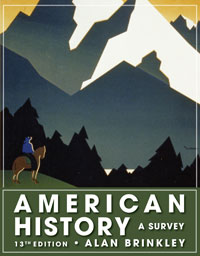American History: A Survey (Brinkley), 13th EditionChapter 1:
THE COLLISION OF CULTURES Main themes of Chapter One: - The colonization of the Americas represented a collision of European and Native American cultures that had been developing along completely different lines for thousands of years.
- A variety of ambitions and impulses moved individuals and nations to colonize the New World, including long-standing demographic and economic changes, religious tensions wrought by the Protestant Reformation, and international rivalries among the European powers.
- The collision of cultures in North America yielded many biological and cultural exchanges that remade both the Old and New Worlds.
- The varied motives of the colonizers and their experiences prior to immigrating worked to shape their attitudes toward Native American cultures and helped determine the sociopolitical arrangements in the new colonies.
- Other than in New Mexico and what would become the American Southwest, North American native peoples were relatively unaffected by European colonization until the arrival of the English, French, and Dutch in the seventeenth century.
- The African slave trade made heavy contributions to the colonization and commerce of the New World, as at least half of all immigrants were made up of Africans forced into slavery.
- Both commercial and religious incentives spurred colonization by the English, who among Western European nations were relatively late in establishing a presence in the New World. They heavily impacted and came to control the eastern coast of North America.
A thorough study of Chapter One should enable the student to understand the following:- The history of Native Americans before the arrival of Europeans to the New World
- The varied societies, populations, and cultures of Native Americans at the time of Christopher Columbus
- The economic, demographic, and political changes in Western Europe that spurred colonization of new lands
- The rise of the Spanish Empire, from Christopher Columbus to the age of "conquistadores"
- The evolution of the Spanish Empire's treatment of Native American peoples
- The biological and cultural exchanges between the New and Old Worlds, including the diseases and crops brought from Europe
- The African cultures from which black slaves were taken, and the early development of the African slave trade
- The economic and religious motives propelling English colonization of the New World
- The early experience of the French and Dutch in North America
- The first efforts of the English to establish a colony in the New World, the lessons they took from their experience in Ireland, and the reasons for their early failures
 | 




